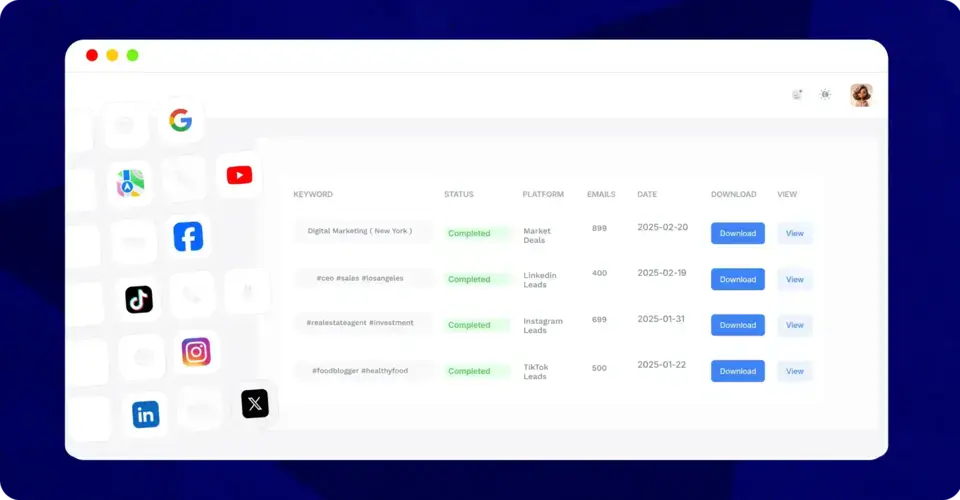Get Fresh Restaurant Email List 2025

In 2025, connecting with restaurant owners and managers is key to selling products, software, or services in the food industry. A clean restaurant email list gives you direct access to decision-makers who handle purchasing, operations, and growth. Instead of relying on outdated contact databases filled with bounced emails and generic addresses, you can now use an email scraper to build your own targeted list of restaurants. In this guide, we’ll show you how to source, refine, and activate a restaurant contact list that’s accurate, compliant, and ready for high-converting outreach.
Top Ways to Get a Fresh Restaurant Email List
Most prebuilt restaurant email lists are recycled, outdated, or filled with irrelevant contacts. If you’ve ever bought one, you’ve probably run into bounced emails, generic inboxes like info@restaurant.com, or outdated venues that have already shut down. The smarter approach in 2025 is to build your own restaurant email list from reliable, public sources. Here are the best methods:
Search LinkedIn with Filters
LinkedIn remains one of the most accurate ways to identify restaurant owners, general managers, or marketing leads. With Sales Navigator, you can filter by industry (“Restaurants”), job title, company size, or location, then enrich the data with an external email scraper.
What to look for:
- Titles like “Restaurant Owner,” “General Manager,” or “Director of Operations”
- Filters for region, cuisine type, or company headcount
- Signals of recent openings, funding, or hiring activity
Use Scraping Tools like IGLeads
A faster, scalable method is to use an email scraper like IGLeads. With IGLeads, you can target restaurants directly across LinkedIn, Google Maps, and business directories, then export clean contact data in minutes.
IGLeads makes it easy to:
- Filter by cuisine, location, or business size
- Collect fresh, accurate emails directly from public sources
- Export your list into a CSV for instant outreach campaigns
Check Restaurant Websites and Directories
For high-value leads, you can manually check restaurant websites or local directories. Many restaurants list manager or owner emails, especially for reservations, catering, or partnerships. While slower, this is effective for building a highly targeted list of specific types of restaurants.
Avoid Low-Quality Vendors
Buying prebuilt lists might seem like a shortcut, but most vendors resell outdated data. If you do consider one, always check how often the list is updated, bounce rate guarantees, and compliance claims. Even then, treat purchased lists as a supplement, not your primary source.
How to Use Your Restaurant Email List Effectively
Having a restaurant email list is only the first step. What matters most is how you use it to start conversations with restaurant owners, managers, or decision-makers, people who are often busy running day-to-day operations. Here’s how to make your outreach count:
Segment Before Sending
Not every restaurant has the same needs. A single-location café will care about low-cost solutions and foot traffic, while a multi-location chain may prioritize logistics and software integrations. Segment your list by cuisine type, restaurant size, or location before you send.
Keep Emails Short and Focused
Restaurant operators don’t have time for long pitches. Aim for under 100 words, highlight one clear benefit, and end with a simple call to action, like scheduling a quick demo or requesting a sample.
Use a Sequence, Not a Single Email
One email won’t cut it. Plan a 3–5 step sequence over 7–10 days. Share case studies, testimonials, or quick wins to build trust without overwhelming their inbox.
Monitor Results and Adapt Quickly
Track open rates, replies, and bounce rates. If engagement is low, test new subject lines, adjust your segments, or refine your offer.
Keep Your List Clean
Update your restaurant contact list regularly. With IGLeads, you can re-run scrapes anytime to capture new openings, job changes, or menu updates, keeping your outreach fresh instead of relying on static databases.
Tips for Keeping Your Restaurant Email List Updated and Compliant
Even the best restaurant email list can lose value quickly if it isn’t maintained. Restaurants frequently change ownership, update contact info, or shut down entirely. A stale list means wasted outreach and poor deliverability. Here’s how to keep yours sharp:
Re-Scrape Regularly
Unlike prebuilt databases, IGLeads lets you run fresh scrapes from public sources whenever you need. This ensures your list reflects current restaurant openings and avoids sending to outdated contacts.
Verify Before Sending
Always run your list through an email verification tool. While IGLeads pulls fresh data, validation helps reduce bounce rates and keeps your sender reputation strong.
Remove Inactive Contacts
If a restaurant hasn’t opened or replied after multiple campaigns, trim them from your list. Smaller, more engaged lists perform far better than bloated ones.
Track Restaurant Changes
Restaurants often switch owners, managers, or even rebrand under new names. Re-running your IGLeads filters makes it easy to capture these updates without starting over.
Respect Compliance Laws
Every outreach campaign should include an unsubscribe option. Since IGLeads only scrapes from public data, it gives you a compliant starting point, but it’s your responsibility to respect opt-outs.
Best Industries and Use Cases for Restaurant Outreach
Restaurants are diverse, and the way you approach them depends heavily on what you’re offering. A well-targeted restaurant email list should reflect these differences so your message feels relevant and valuable.
Food & Beverage Suppliers
Restaurants need a constant supply of ingredients, beverages, and specialty products. Outreach works when you show how you can reduce costs, improve delivery speed, or provide unique items that help them stand out.
They respond well to:
- Wholesale pricing offers
- Local sourcing options
- Exclusive product catalogs
POS & Restaurant Software Providers
Owners and managers are under pressure to streamline operations. Point-of-sale systems, reservation software, and staff management tools are high-value solutions if positioned correctly.
They respond well to:
- Efficiency improvements
- Cost savings vs. existing systems
- Integrations with delivery apps or accounting tools
Marketing & Advertising Agencies
Many restaurants struggle with customer acquisition. Agencies offering social media growth, email marketing, or local SEO can tap into this demand, especially for independent restaurants.
They respond well to:
- Proven ROI from past campaigns
- Customer loyalty programs
- Done-for-you marketing services
Delivery & Logistics Partners
With delivery booming in 2025, restaurants look for reliable logistics partners. From packaging suppliers to courier services, these businesses can use restaurant email lists to pitch directly to decision-makers.
They respond well to:
- Fast, affordable shipping options
- Eco-friendly packaging solutions
- Partnerships with food delivery platforms
Equipment & Maintenance Providers
From kitchen appliances to cleaning services, restaurants constantly need reliable partners. Outreach should focus on cost efficiency and reducing downtime.
They respond well to:
- Leasing or financing options
- 24/7 maintenance services
- Energy-efficient equipment
Build Your Restaurant Email List the Smart Way
Ready to connect directly with restaurant owners and managers? With IGLeads, you don’t need coding skills or expensive data providers. Just set your filters, run the email scraper, and export a fresh restaurant email list in minutes.
Sign up today and start building accurate, targeted outreach lists without relying on outdated contact databases.
Essential Guides for Lead Generation
- B2B Lead Generation Solutions – Guide for 2025
- How to Build a High-Quality B2B Email List for Outbound Marketing
- Buy Email Lists for Marketing in 2025: Complete Guide to Business Leads
- Why Scrape Google Maps? Use Cases for Sales, Marketing & SEO
- B2C Lead Generation: The 2025 Playbook
- 15 Best Lead Generation Companies for 2025
- Best B2B email list providers in 2025
- Top Lead Generation Agencies Compared (2025)
- 18 Best B2B Lead Generation softwares in 2025
- Lead Generation Guide: Strategies & Tools for 2025
Frequently Asked Questions
Yes. Collecting data from public sources like websites or directories is legal, but always include an unsubscribe option to stay compliant.
Every 30–60 days. Restaurants change ownership and contact details frequently, so regular updates keep your outreach accurate.
You can, but most prebuilt lists are outdated or filled with generic inboxes. Using an email scraper ensures fresher, more targeted contacts.
Suppliers, POS and software providers, marketing agencies, delivery partners, and equipment or maintenance companies.
IGLeads. It lets you filter by cuisine, location, or business type and export clean contact data into a CSV file for campaigns.





